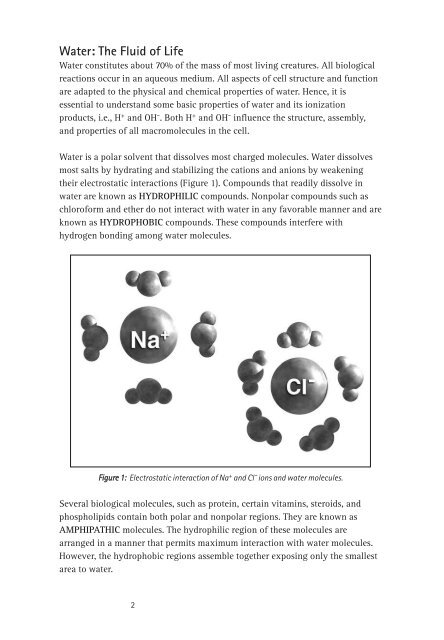A guide for the preparation and use of buffers in biological systems
A guide for the preparation and use of buffers in biological systems
A guide for the preparation and use of buffers in biological systems
Create successful ePaper yourself
Turn your PDF publications into a flip-book with our unique Google optimized e-Paper software.
Water: The Fluid <strong>of</strong> Life<br />
Water constitutes about 70% <strong>of</strong> <strong>the</strong> mass <strong>of</strong> most liv<strong>in</strong>g creatures. All <strong>biological</strong><br />
reactions occur <strong>in</strong> an aqueous medium. All aspects <strong>of</strong> cell structure <strong>and</strong> function<br />
are adapted to <strong>the</strong> physical <strong>and</strong> chemical properties <strong>of</strong> water. Hence, it is<br />
essential to underst<strong>and</strong> some basic properties <strong>of</strong> water <strong>and</strong> its ionization<br />
products, i.e., H + <strong>and</strong> OH¯. Both H + <strong>and</strong> OH¯ <strong>in</strong>fluence <strong>the</strong> structure, assembly,<br />
<strong>and</strong> properties <strong>of</strong> all macromolecules <strong>in</strong> <strong>the</strong> cell.<br />
Water is a polar solvent that dissolves most charged molecules. Water dissolves<br />
most salts by hydrat<strong>in</strong>g <strong>and</strong> stabiliz<strong>in</strong>g <strong>the</strong> cations <strong>and</strong> anions by weaken<strong>in</strong>g<br />
<strong>the</strong>ir electrostatic <strong>in</strong>teractions (Figure 1). Compounds that readily dissolve <strong>in</strong><br />
water are known as HYDROPHILIC compounds. Nonpolar compounds such as<br />
chloro<strong>for</strong>m <strong>and</strong> e<strong>the</strong>r do not <strong>in</strong>teract with water <strong>in</strong> any favorable manner <strong>and</strong> are<br />
known as HYDROPHOBIC compounds. These compounds <strong>in</strong>terfere with<br />
hydrogen bond<strong>in</strong>g among water molecules.<br />
Figure 1: Electrostatic <strong>in</strong>teraction <strong>of</strong> Na + <strong>and</strong> Cl¯ ions <strong>and</strong> water molecules.<br />
Several <strong>biological</strong> molecules, such as prote<strong>in</strong>, certa<strong>in</strong> vitam<strong>in</strong>s, steroids, <strong>and</strong><br />
phospholipids conta<strong>in</strong> both polar <strong>and</strong> nonpolar regions. They are known as<br />
AMPHIPATHIC molecules. The hydrophilic region <strong>of</strong> <strong>the</strong>se molecules are<br />
arranged <strong>in</strong> a manner that permits maximum <strong>in</strong>teraction with water molecules.<br />
However, <strong>the</strong> hydrophobic regions assemble toge<strong>the</strong>r expos<strong>in</strong>g only <strong>the</strong> smallest<br />
area to water.<br />
2
















